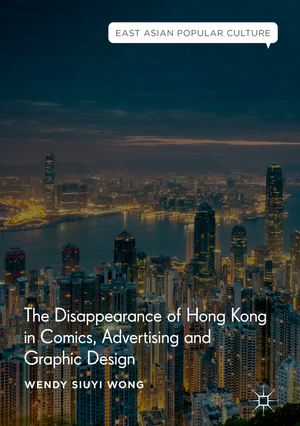The Disappearance of Hong Kong in Comics, Advertising and Graphic Design: East Asian Popular Culture
Autor Wendy Siuyi Wongen Limba Engleză Hardback – 3 noi 2018
| Toate formatele și edițiile | Preț | Express |
|---|---|---|
| Paperback (1) | 384.09 lei 43-57 zile | |
| Springer International Publishing – 9 feb 2019 | 384.09 lei 43-57 zile | |
| Hardback (1) | 505.30 lei 43-57 zile | |
| Springer International Publishing – 3 noi 2018 | 505.30 lei 43-57 zile |
Din seria East Asian Popular Culture
- 9%
 Preț: 814.98 lei
Preț: 814.98 lei -
 Preț: 345.89 lei
Preț: 345.89 lei - 18%
 Preț: 888.97 lei
Preț: 888.97 lei - 18%
 Preț: 781.31 lei
Preț: 781.31 lei - 18%
 Preț: 784.79 lei
Preț: 784.79 lei - 18%
 Preț: 731.41 lei
Preț: 731.41 lei - 15%
 Preț: 585.08 lei
Preț: 585.08 lei - 15%
 Preț: 645.47 lei
Preț: 645.47 lei - 15%
 Preț: 707.46 lei
Preț: 707.46 lei - 15%
 Preț: 587.72 lei
Preț: 587.72 lei - 18%
 Preț: 795.36 lei
Preț: 795.36 lei - 15%
 Preț: 583.45 lei
Preț: 583.45 lei - 15%
 Preț: 520.61 lei
Preț: 520.61 lei - 15%
 Preț: 581.14 lei
Preț: 581.14 lei - 15%
 Preț: 582.80 lei
Preț: 582.80 lei - 15%
 Preț: 579.34 lei
Preț: 579.34 lei -
 Preț: 378.54 lei
Preț: 378.54 lei - 9%
 Preț: 740.90 lei
Preț: 740.90 lei -
 Preț: 378.54 lei
Preț: 378.54 lei - 15%
 Preț: 691.91 lei
Preț: 691.91 lei - 15%
 Preț: 641.38 lei
Preț: 641.38 lei - 18%
 Preț: 776.88 lei
Preț: 776.88 lei - 8%
 Preț: 578.16 lei
Preț: 578.16 lei - 18%
 Preț: 728.91 lei
Preț: 728.91 lei - 15%
 Preț: 695.34 lei
Preț: 695.34 lei - 18%
 Preț: 726.06 lei
Preț: 726.06 lei - 18%
 Preț: 726.69 lei
Preț: 726.69 lei
Preț: 505.30 lei
Preț vechi: 594.48 lei
-15% Nou
Puncte Express: 758
Preț estimativ în valută:
96.72€ • 105.09$ • 81.30£
96.72€ • 105.09$ • 81.30£
Carte tipărită la comandă
Livrare economică 21 aprilie-05 mai
Preluare comenzi: 021 569.72.76
Specificații
ISBN-13: 9783319920955
ISBN-10: 3319920952
Pagini: 216
Ilustrații: XIX, 245 p. 48 illus., 25 illus. in color.
Dimensiuni: 148 x 210 mm
Greutate: 0.59 kg
Ediția:1st ed. 2018
Editura: Springer International Publishing
Colecția Palgrave Macmillan
Seria East Asian Popular Culture
Locul publicării:Cham, Switzerland
ISBN-10: 3319920952
Pagini: 216
Ilustrații: XIX, 245 p. 48 illus., 25 illus. in color.
Dimensiuni: 148 x 210 mm
Greutate: 0.59 kg
Ediția:1st ed. 2018
Editura: Springer International Publishing
Colecția Palgrave Macmillan
Seria East Asian Popular Culture
Locul publicării:Cham, Switzerland
Cuprins
1. Introduction: The unveiling of the disappearance.- 2. Tracing the origins of Hong Kong manhua: A case of culture of disappearance.- 3. Reinventing Hong Kong manhua: A case of the non-appearance.- 4. A history of Hong Kong comics in film adaptations: The appearance of self-identities.- 5. Construction of Hong Kong modern living: Household product and appliance advertisements in the pre-television era.- 6. Reconfiguring a new tradition of ideal family size: A case study of the Family Planning Association of Hong Kong, 1977–1982.- 7. Transitory identity of Hong Kong: A Reading of Cathay Pacific Airways Television Commercials.- 8. Negotiating the marginalized identity of Hong Kong: A case in graphic design.- 9. An international design identity of Hong Kong: Colonization, decolonization, and recolonization.- 10. Not the same: Rethinking Chineseness in a global context through poster design.
Recenzii
“This book could prove useful for those interested in the shifting dynamics of Hong Kong and how it is reflected in media such as scholars and professionals in the fields of diplomacy, history, communication, and cultural studies.” (Tyler M. Wilson, CBQ Communication Booknotes Quarterly, Vol. 51 (3-4), 2020)
Notă biografică
Wendy Siuyi Wong is Professor in the Department of Design at York University in Toronto, Canada. She has taught in Hong Kong, the United States and Australia, and has established an international reputation as an expert in Chinese graphic design history and Chinese comic art history.
Caracteristici
Analyzes the evolution of the rise and fall with a focus on cultural identity towards the latest developments in creative expression under China’s promised “one country, two systems” rhetoric, and the current state of cultural identity in the context of Hong Kong’s subsumption as one of China’s many cities Provides a comprehensive background for not only an understanding of Hong Kong’s cultural identity through these three under-investigated media, but also a transnational understanding of Hong Kong cultural identity within the East Asian region Utilizes Hong Kong as a case study to demonstrate the potential of these three media for a global understanding of our world visual cultures
